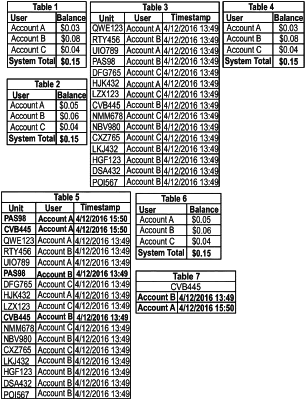| CPC G06Q 20/10 (2013.01) [G06Q 20/065 (2013.01); G06Q 20/389 (2013.01)] | 12 Claims |

|
1. A method for tracing electronic financial transactions, the method comprising:
generating and storing in memory, by a processor of a payment system, an account identifier mapping table including first entries that map unique identifiers to a plurality of accounts based on balances of the plurality of accounts,
wherein each first entry includes a unique identifier, an account identifier, and a time stamp that indicates when that first entry was added to the account identifier mapping table,
wherein each unique identifier has a predetermined monetary value, and
wherein each unique identifier is a unique bit sequence;
adding, by the processor for electronic transactions between the plurality of accounts, second entries to the account identifier mapping table stored in the memory, each second entry including an account identifier of a recipient account in a respective electronic transaction, a time stamp of when the respective electronic transaction occurred, and a respective one of the unique identifiers involved in the respective electronic transaction;
determining, at any given time for a respective account in the plurality of accounts, a balance of the respective account as being equal to a sum of the predetermined monetary values of a set of the unique identifiers that are mapped to the respective account and that have the latest time stamps among the first entries and the second entries;
receiving, by the processor from an external source, an inquiry containing a plurality of suspected or known illicit accounts, wherein the inquiry requests to determine whether a first account has a transaction history that traces back to at least one of the plurality of suspected or known illicit accounts;
accessing, by the processor, the memory that includes the account identifier mapping table, identifying entries that involve the first account, and producing a first output table with the identified entries, the first output table including:
an entry from the account identifier mapping table having an account identifier of the first account, a first unique identifier, and a first timestamp of when the first unique identifier was mapped to the first account;
an entry from the account identifier mapping table having the account identifier of the first account, a second unique identifier, and a second timestamp of when the second unique identifier was mapped to the first account; and
an entry in the account identifier mapping table having the account identifier of the first account, a third unique identifier, and a third timestamp of when the third unique identifier was mapped to the first account;
accessing, by the processor, the memory that includes the account identifier mapping table, identifying entries that include the first unique identifier, and producing a second output table with the identified entries, the second output table including:
an entry from the account identifier mapping table having an account identifier of a second account, the first unique identifier, and a fourth timestamp of when the first unique identifier was mapped to the second account;
an entry from the account identifier mapping table having an account identifier of a third account, the first unique identifier, and a fifth timestamp of when the first unique identifier was mapped to the third account; and
an entry from the account identifier mapping table having an account identifier of a fourth account, the first unique identifier, and a sixth timestamp of when the first unique identifier was mapped to the fourth account;
comparing, by the processor, the account identifiers of the second, third, and fourth accounts in the second output table with account identifiers of the plurality of suspected or known illicit accounts; and
determining, by the processor and based on the comparing, that the first account has been involved in an illicit transaction when the account identifier of one of the second, third, or fourth accounts matches an account identifier of one of the plurality of suspected or known illicit accounts.
|